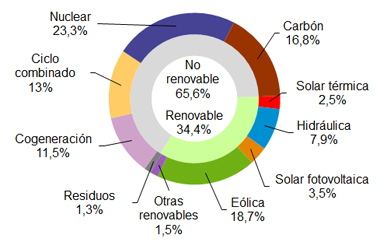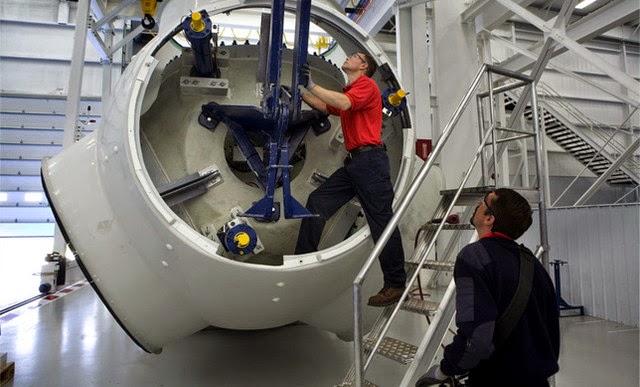GE Renewable Energy to provide 179 of its 3.6-137 wind turbines to Markbygden ETT wind farm, currently the largest single site onshore wind installation to be delivered in Europe. Green Investment Group and GE Energy Financial Services partner as 50/50 equity investors to acquire the project from Svevind and raise remaining capital from debt markets.Landmark project financing structure brings together European Investment Bank (EIB), Export Credit Guarantees of the Federal Republic of Germany (Hermes Cover), NordLB, KfW IPEX-Bank and HSH Nordbank. Norsk Hydro to purchase the power via a 19-year fixed volume corporate PPA; understood to be the largest corporate wind energy PPA in the world.
![]()
GE and Green Investment Group Limited ("Green Investment Group"), part of Macquarie Group ("Macquarie"), have partnered to deliver and operate 650-MW of onshore wind through the Markbygden ETT wind farm in Northern Sweden. The project will be the largest single site onshore wind farm in Europe, increasing Sweden's installed wind generation by more than 12.5 percent. The equity partners raised approximately €800M in financing and have commenced construction of the project, which is expected to begin commissioning turbines in the second half of 2018 and be fully operational by the end of 2019.
GE Renewable Energy will supply 179 of its 3.6 MW turbines with 137 meter rotors, a turbine ideally suited for the project site's wind speeds and climate. The turbine blades will be equipped with an innovative ice mitigation system by LM Wind Power, ensuring a stable level of availability and reduced downtime. GE is also providing a 20-year Full Service Agreement, and through its Grid Solutions business, will provide the high voltage switchgear for two collector substations at the wind farm.
Pete McCabe, President & CEO of GE's Onshore Wind Business, said, "We are excited to have been chosen by Svevind to contribute to this massive project. Markbygden ETT marks our commitment to the Swedish onshore wind arena and extends our presence in Europe while showcasing our technical capabilities – with LM Wind Power – and project development and management differentiators."
Project Financing
GE Energy Financial Services and Green Investment Group ("the Sponsors") have jointly acquired the project from Svevind and invested more than €300M in equity to finance the wind farm. The transaction is Green Investment Group's first equity investment following its acquisition by Macquarie and its first investment outside of the United Kingdom. For GE, it represents GE Capital's strategy to invest in and structure financing solutions in support of GE in key global growth markets.
Edward Northam, Head of the Green Investment Group in Europe, said, "This project is a landmark transaction on many fronts and represents the new frontier in European onshore wind. It demonstrates that in the right market, with the right location, the right technology and the right partners, it is possible to develop and attract private capital into new onshore wind farms."
Mark Dooley, Global Head of Green Energy, Macquarie Capital, added, "We are pleased to build on our strategic partnership with GE and to continue our pioneering role in the global transition towards a low-carbon economy."
Brian Ward, Head of Global Markets, GE Energy Financial Services, said, "Markbygden ETT represents GE's unique ability to package technology and investing expertise to structure integrated off-take and financing solutions. This, combined with the depth of talent at the Green Investment Group, enabled Markbygden ETT to reach financial close in the competitive Nordic onshore wind market and achieve many market firsts."
The Sponsors' financial advisory teams sought a mix of funding from development institutions, the export-credit market and commercial banks familiar with the Nordic energy market. The project was financed on a non-recourse project financing basis with close to €500M in debt financing secured from European Investment Bank (EIB), Export Credit Guarantees of the Federal Republic of Germany (Hermes Cover), NordLB (acting as MLA advisor and ECA bank), KfW IPEX-Bank and HSH Nordbank.
GE and Green Investment Group originated and structured a 19-year fixed volume Power Purchase Agreement (PPA) with a subsidiary of Norsk Hydro, one of the largest aluminum producers in the world. The PPA enables Norsk Hydro to fix the price of a significant portion of the electricity demand for their Norwegian aluminum manufacturing facilities, producing approximately 100,000 tonnes of aluminum per year. NEAS Energy (part of Centrica plc) will provide an innovative structure for the sale of Elcerts (renewable energy certificates), balancing and hedging services for Markbygden ETT. The PPA is understood to be the largest corporate wind energy PPA in the world.
Green Investment Group conducted a green impact assessment on the project, using the green reporting approach set out in its Green Investment Handbook.
The Markbygden ETT project was developed over 15 years by Swedish wind developer Svevind. In total, its development work in the Markbygden area may lead to 1,101 wind turbines becoming operational, in what would be the largest collection of wind farms in Europe. The project will be realized on properties owned by Sveaskog Förvaltnings AB, Sweden's largest forest owner, SCA Skogsfastigheter AB, the largest private forest holding in Europe, and several private property owners.
Wolfgang Kropp, CEO of Svevind, said, "Having worked on the development of the Markbygden cluster of wind farm projects since 2002, Svevind is very excited to see this partnership with GE Renewables, GE Energy Financial Services, and the Green Investment Group come to fruition. We are pleased to see the success of our hard work demonstrated by the attention the Markbygden ETT project has attracted from world class institutions such as these. We look forward to seeing this project, and future projects around Markbygden, constructed and contributing to the much-needed fight against climate change."
GE Renewable Energy is a $10 billion start-up that brings together one of the broadest product and service portfolios of the renewable energy industry. Combining onshore and offshore wind, hydro and innovative technologies such as concentrated solar power and more recently turbine blades, GE Renewable Energy has installed more than 400+ gigawatts capacity globally to make the world work better and cleaner. With more than 22,000 employees present in more than 55 countries, GE Renewable Energy is backed by the resources of the world's first digital industrial company. Our goal is to demonstrate to the rest of the world that nobody should ever have to choose between affordable, reliable, and sustainable energy.
A strategic GE Capital business, GE Energy Financial Services is a global energy investor that provides financial solutions that help meet the world's energy needs. Drawing on its technical know-how, financial strength and strong risk management, GE Energy Financial Services invests in long-lived and capital-intensive projects and companies. The firm has 35+ years of experience managing energy assets through multiple economic cycles, and a global portfolio that spans conventional and renewable power, and oil and gas infrastructure projects. It is headquartered in Stamford, CT with regional hubs in London, Houston, Hong Kong and Nairobi.
Green Investment Group is a specialist in green infrastructure principal investment, project delivery and the management of portfolio assets, and related services. Its track record, expertise and capability make it a global leader in green investment, dedicated to supporting the growth of the global green economy.
The business was launched initially by the UK Government in 2012 as the first institution of its type in the world. The organisation was acquired by the diversified financial group Macquarie Group Limited in 2017, creating one of Europe's largest teams of dedicated green infrastructure investors, and now operates under the name Green Investment Group.
Macquarie Group Limited (Macquarie) is a diversified financial group, providing clients with asset management and finance, banking, advisory and risk and capital solutions across debt, equity and commodities. Founded in 1969, Macquarie employs 13,966 people in 27 countries. At 30 September 2017, Macquarie had assets under management of £277.2 billion.
Svevind is a privately-owned leading developer, owner and operator of onshore wind projects in Sweden. Founded in 1998, Svevind has a record of permitting approximately 4,000 MW of wind projects in Sweden, of which 226 MW are in operation and 833 MW are under construction. Additionally, with Markbygden ETT entering its portfolio Svevind also provides operation and asset management services for 850 MW of wind projects in Sweden through its subsidiary Svevind Solutions.
























